May 18, 2007
Cutter Conundrum' and Coastie Window Shopping
Note: This is reposted from by old blog. Since this first posted in March of '07 there have been several developments, Despite it's age I will likely update this post at some point.
The Coast Guard's patrol boats are getting long in the tooth and are desperately in need of a replacement.
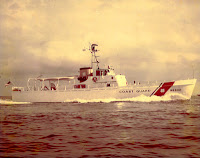
The immediate problems go back to the '80s.
The Coast Guard had large numbers of 82' and 95' patrol boats. All were slow but useful. The 95 foot boats had been designed in WW2 and produced over several years in different batches, their hulls were quite worn out, the 82'Point class had been built in the '60s they were cramped but useful vessels though a large number had been given to Viet Nam to assist that nation in its attempt to stave off the evil that ultimately consumed it.
As a stop-gap, the Island class patrol boats were ordered in small numbers in fits and starts in the early to mid 80's. Congress was unwilling to fund the CG and they were collateral items in drug war legislation with some actually being bought for the CG by the Navy! The design was (by congressional order) not an American one but an off the shelf Vosper export design. Now the Brits have nothing to learn in the field of shipbuilding, but this was an export design that put paper performance ahead of operational characteristics. The Coast Guard knew this but they needed something fast to catch drug smugglers, the ships could be built very quickly and anyway, they were just considered a stopgap until the Leopold Class was to be commissioned in the early '90s.
The Leopold class was an interesting design. A very strongly built 120 foot patrol boat the craft would have been capable of 30 knots or more despite far stronger construction than the lightly built 110's. They embodied every lesson learned in Patrol Boat ops for the last several decades. They would have had a secondary coastal ASW capability in wartime. These cutters were much needed replacements for a hundred small cutters that were at or past the end of their service lives and the USCG had high hopes for them.
Alas, the Congress canceled them around 1990. A few more 110's were ordered, but the Coast Guard has had a patrol boat deficit since the late '80s. Leopold was laid up incomplete and ordered scrapped.
In the mid 90's a different Congress financed the 87' Barracuda class.
These are quite small cutters. They are NOT replacements for the seagoing 95's and 110's. They are really revenue and law enforcement boats. In those tasks they excel, especially as they are small enough and have a shallow enough draft to get into nearly all small boat stations, and patrol and conduct rescues inshore (an important and little appreciated requirement).
In the late 90's and early 'naughts the first batches of 110's were coming up on the end of their design lives and generating harrowing sea stories for their crews. The Coast Guard began looking at replacements and began designing the ideal cutter of the future.
The ICOF involved a lot of design work as it was to have a composite hull for long life, high speed, high fuel efficiency, a high degree of automation, be operable in any sea state and generally be a mass of conflicting requirements....all under 150 feet in length.
The composite hull took time to develop and the materials science did not progress as planned. The CG wanted to integrate the new Deepwater C4I systems into the new vessels from the start and wanted a homogeneous class for ease and inexpensiveness of maintainability.
The solution to this delay was to completely refurbish the 110's into 123's adding the safer and manpower-saving stern launching arrangements of the 87's. The vessels were stretched 13 feet, their hulls were refurbished and prototypes of the new communications system were installed. This was a logical choice to compensate for the delays in the new design. The planned future vessels would come online as the 123's were wearing out and machinery and equipment in the maintenance pipelines could be switched at once.
Unfortunately the 110' hull did not stretch well.
Unlike a certain-other-debacle this does not seem to be the result of failure to do ones job, but rather a genuine marine engineering learning experience. The stretched hulls were extensively computer tested, but certain choppy seas cause stresses that were not foreseen in the lightly built hulls. The result was yet more harrowing sea stories and the laying up of the refitted ships.
Now there is a problem....the CG needs patrol boats....like yesterday.
But what should they buy, the ultimate cutter design is still decade or 2 off and we have got to get something in the water now.
I'm not an engineer nor a Boatswains mate. I'm certainly not an officer, but this is a BLOG! So keeping in mind my stock disclaimer, here are my thoughts on the matter as I commence tilting at windmills far above my paygrade!
First thing! No more surprises....off the shelf designs only for now.
One obvious choice would be the NAVY/Coast Guard Cyclone class patrol boat. It's very highly regarded in Coast Guard service, uses the same diesels the CG 110's use, is fast and is already in service .
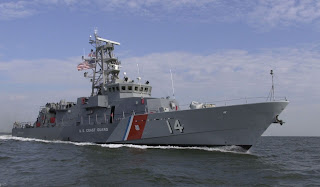
From Australia we have this well proven design from Tenix. Their 56 meter Search and Rescue
craft is based on their stock 57m fast attack craft, but it has
actually been built! Two were delivered to the Philippines a few years
ago. The Philippine Coast Guard is so pleased with the design that they
are ordering 6 more of these
instead of buying more of the similarly sized Cyclone class ships (they
operate 1 of those too). The design is interesting for a number of
reasons. It is reasonably fast (26 kts). It has a large (enclosed)
rescue deck for survivors (or migrants). It is very seaworthy and
despite its small size it has a landing deck for a small helicopter.
There is no hangar but the cutter seems to have a similar capability to
the larger Reliance class cutters
with 1 third the crew in a package 7knots faster and no bigger than the
Cyclone class...ie one that can fit in many Coast Guard stations. It's
20-30 feet longer than the CG seems to want but its manning is
reasonable (though admittedly 10 more than a 110'). It is likely more
seaworthy than a 110' and it is very well adapted to SAR duty. In all
likelihood its maintenance and operations costs are fairly low (these
being of PARAMOUNT importance to the Philippine Coast Guard).
Their 56 meter Search and Rescue
craft is based on their stock 57m fast attack craft, but it has
actually been built! Two were delivered to the Philippines a few years
ago. The Philippine Coast Guard is so pleased with the design that they
are ordering 6 more of these
instead of buying more of the similarly sized Cyclone class ships (they
operate 1 of those too). The design is interesting for a number of
reasons. It is reasonably fast (26 kts). It has a large (enclosed)
rescue deck for survivors (or migrants). It is very seaworthy and
despite its small size it has a landing deck for a small helicopter.
There is no hangar but the cutter seems to have a similar capability to
the larger Reliance class cutters
with 1 third the crew in a package 7knots faster and no bigger than the
Cyclone class...ie one that can fit in many Coast Guard stations. It's
20-30 feet longer than the CG seems to want but its manning is
reasonable (though admittedly 10 more than a 110'). It is likely more
seaworthy than a 110' and it is very well adapted to SAR duty. In all
likelihood its maintenance and operations costs are fairly low (these
being of PARAMOUNT importance to the Philippine Coast Guard).
Versatility is the watchword of the Coast Guard, and few vessels are as versatile as Denmark's Flyvefisken class.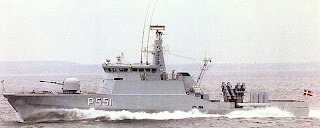 These
35 knot vessels are nominally fast attach craft, but are fitted with
modules for pollution control, search and rescue, oceanography as well
as 4 weapons modules for SSMs, SAMs minesweeping gear, and torpedoes.
The heavy weapons are superfluous in CG service but a case might be made for one or more of the neat 12 packs of Evolved Seasparrows or perhaps a SeaRAM
on overseas deployments. Sooner or later an asshat is going to take a
potshot at a cutter with a missile and a good point defense missile
would be useful...especially onewith secondary antiship
capability...decadent I know.... the point is the vessel is quite
adaptable to a war situation if necessary.
These
35 knot vessels are nominally fast attach craft, but are fitted with
modules for pollution control, search and rescue, oceanography as well
as 4 weapons modules for SSMs, SAMs minesweeping gear, and torpedoes.
The heavy weapons are superfluous in CG service but a case might be made for one or more of the neat 12 packs of Evolved Seasparrows or perhaps a SeaRAM
on overseas deployments. Sooner or later an asshat is going to take a
potshot at a cutter with a missile and a good point defense missile
would be useful...especially onewith secondary antiship
capability...decadent I know.... the point is the vessel is quite
adaptable to a war situation if necessary.
The HUGE workdeck (used for mines and torpedo tubes in RDN service) would lend itself admirably to ATON (aids to navigation) work and pollution control in the rare cases the CG has to do that. Base crew without the big weapons (which the CG would rarely if ever use) is 19....very economical indeed. There are 4 modules for weapons or other kit. Forward the Danish models are fitted with a 76mm gun so the CG's superb 57mm weapon would be no problem, let alone the smaller guns we could actually afford to put on it right now.The hull is constructed of a fibre-reinforced plastic! Despite this, these ships are minimally ice strengthened (but NOT ice breaking) and designed to operate safely in some of the worst seas on the planet...the Atlantic between Denmark and Greenland. This is a VAST improvement upon the CG's 110's (which, with their hull plating about the thickness of a nickel(!) do not deal well with ice).
With a waterline length of 164 feet it is closer to what the Coast Guard says it needs. The speed is remarkable but depends on a gas turbine, (fuel hawg!) note that on cruising diesels alone the speed of these vessels is still 20 kts A Coast Guard version would likely make 26-30 kts on uprated diesels not optimized for cruising, or perhaps 4 diesels (possibly at the expense of one of the mission modules). I like this one a LOT.
Going a bit smaller we come to this Lurrsen design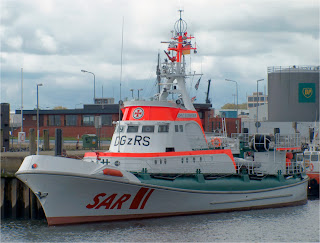 for the German Sea Rescue Service. Only 144 feet long, and drawing 10 feet of water, these ice strengthened vessels
are capable of 26 knots, have a stern launched rescue boat, and are
designed with north sea winters in mind. The big fire monitor on the
bow could easily be replaced with a machine gun or light auto-cannon.
Incredibly, they have a small helipad for light helicopters, and though
this tiny platform might give airdales
harrowing seastories, it is a useful emergency capability to have,
extending the range of small choppers or allowing wounded rescuees to
be medi-vacd. The German Maritime Rescue Service is a civilian organization that exists only by private donations therefore
economy of operation is high on their priority list. These vessels were
built in the 70's and are very highly regarded. Lurrsen still
advertises being ready to build them and the company seems quite proud
of the design.
for the German Sea Rescue Service. Only 144 feet long, and drawing 10 feet of water, these ice strengthened vessels
are capable of 26 knots, have a stern launched rescue boat, and are
designed with north sea winters in mind. The big fire monitor on the
bow could easily be replaced with a machine gun or light auto-cannon.
Incredibly, they have a small helipad for light helicopters, and though
this tiny platform might give airdales
harrowing seastories, it is a useful emergency capability to have,
extending the range of small choppers or allowing wounded rescuees to
be medi-vacd. The German Maritime Rescue Service is a civilian organization that exists only by private donations therefore
economy of operation is high on their priority list. These vessels were
built in the 70's and are very highly regarded. Lurrsen still
advertises being ready to build them and the company seems quite proud
of the design.
Their likely replacements are represented by the very similar (but slightly larger ) Herman Marwede. A bit slower with a much higher superstructure, this vessels helicopter arrangements seem less....scary.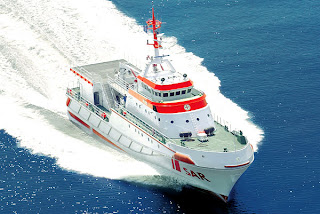 The
high focs'le looks to improve seakeeping but the moderate freeboard and
flush deck of the Essberger might be better for some SAR situations
(yes I'm way beyond my expertise here). I'm not sure if this ship is
ice strengthened, but given the operating area I'd be surprised if it
wasn't. The ship is still brand new so I don't know if it is as well
regarded as the Essbergers.
The
high focs'le looks to improve seakeeping but the moderate freeboard and
flush deck of the Essberger might be better for some SAR situations
(yes I'm way beyond my expertise here). I'm not sure if this ship is
ice strengthened, but given the operating area I'd be surprised if it
wasn't. The ship is still brand new so I don't know if it is as well
regarded as the Essbergers.
*******************************************************************
There are myriad other designs as well by many very highly regarded naval architects, but these are in service, seem to be working quite well and are reasonably economical to operate.
So let's buy something!
Anyhow this concludes my un-liscenced foray into marine procurement.
UPDATE: Welcome Murdoc Online readers!
UPDATE2: Note that in referring to the 123s STRUCTURAL problems as unforeseen, I was not suggesting that the other issues that have been widely reported were as well. However the contractor related issues regards wiring and shielding, were, as I understand it, not nearly as serious as some reports suggested and were fixed almost immediately.
Also, while the work-deck of the Danish craft would make them useful as supplemental buoy tenders, the lack of both a full sized buoy hold and a true icebreaking capability would mean that the versatile "black hull fleet" would still be needed.
The Coast Guard's patrol boats are getting long in the tooth and are desperately in need of a replacement.

The immediate problems go back to the '80s.
The Coast Guard had large numbers of 82' and 95' patrol boats. All were slow but useful. The 95 foot boats had been designed in WW2 and produced over several years in different batches, their hulls were quite worn out, the 82'Point class had been built in the '60s they were cramped but useful vessels though a large number had been given to Viet Nam to assist that nation in its attempt to stave off the evil that ultimately consumed it.
As a stop-gap, the Island class patrol boats were ordered in small numbers in fits and starts in the early to mid 80's. Congress was unwilling to fund the CG and they were collateral items in drug war legislation with some actually being bought for the CG by the Navy! The design was (by congressional order) not an American one but an off the shelf Vosper export design. Now the Brits have nothing to learn in the field of shipbuilding, but this was an export design that put paper performance ahead of operational characteristics. The Coast Guard knew this but they needed something fast to catch drug smugglers, the ships could be built very quickly and anyway, they were just considered a stopgap until the Leopold Class was to be commissioned in the early '90s.
The Leopold class was an interesting design. A very strongly built 120 foot patrol boat the craft would have been capable of 30 knots or more despite far stronger construction than the lightly built 110's. They embodied every lesson learned in Patrol Boat ops for the last several decades. They would have had a secondary coastal ASW capability in wartime. These cutters were much needed replacements for a hundred small cutters that were at or past the end of their service lives and the USCG had high hopes for them.
Alas, the Congress canceled them around 1990. A few more 110's were ordered, but the Coast Guard has had a patrol boat deficit since the late '80s. Leopold was laid up incomplete and ordered scrapped.
In the mid 90's a different Congress financed the 87' Barracuda class.
These are quite small cutters. They are NOT replacements for the seagoing 95's and 110's. They are really revenue and law enforcement boats. In those tasks they excel, especially as they are small enough and have a shallow enough draft to get into nearly all small boat stations, and patrol and conduct rescues inshore (an important and little appreciated requirement).
In the late 90's and early 'naughts the first batches of 110's were coming up on the end of their design lives and generating harrowing sea stories for their crews. The Coast Guard began looking at replacements and began designing the ideal cutter of the future.
The ICOF involved a lot of design work as it was to have a composite hull for long life, high speed, high fuel efficiency, a high degree of automation, be operable in any sea state and generally be a mass of conflicting requirements....all under 150 feet in length.
The composite hull took time to develop and the materials science did not progress as planned. The CG wanted to integrate the new Deepwater C4I systems into the new vessels from the start and wanted a homogeneous class for ease and inexpensiveness of maintainability.
The solution to this delay was to completely refurbish the 110's into 123's adding the safer and manpower-saving stern launching arrangements of the 87's. The vessels were stretched 13 feet, their hulls were refurbished and prototypes of the new communications system were installed. This was a logical choice to compensate for the delays in the new design. The planned future vessels would come online as the 123's were wearing out and machinery and equipment in the maintenance pipelines could be switched at once.
Unfortunately the 110' hull did not stretch well.
Unlike a certain-other-debacle this does not seem to be the result of failure to do ones job, but rather a genuine marine engineering learning experience. The stretched hulls were extensively computer tested, but certain choppy seas cause stresses that were not foreseen in the lightly built hulls. The result was yet more harrowing sea stories and the laying up of the refitted ships.
Now there is a problem....the CG needs patrol boats....like yesterday.
But what should they buy, the ultimate cutter design is still decade or 2 off and we have got to get something in the water now.
I'm not an engineer nor a Boatswains mate. I'm certainly not an officer, but this is a BLOG! So keeping in mind my stock disclaimer, here are my thoughts on the matter as I commence tilting at windmills far above my paygrade!
First thing! No more surprises....off the shelf designs only for now.
One obvious choice would be the NAVY/Coast Guard Cyclone class patrol boat. It's very highly regarded in Coast Guard service, uses the same diesels the CG 110's use, is fast and is already in service .

From Australia we have this well proven design from Tenix.
 Their 56 meter Search and Rescue
craft is based on their stock 57m fast attack craft, but it has
actually been built! Two were delivered to the Philippines a few years
ago. The Philippine Coast Guard is so pleased with the design that they
are ordering 6 more of these
instead of buying more of the similarly sized Cyclone class ships (they
operate 1 of those too). The design is interesting for a number of
reasons. It is reasonably fast (26 kts). It has a large (enclosed)
rescue deck for survivors (or migrants). It is very seaworthy and
despite its small size it has a landing deck for a small helicopter.
There is no hangar but the cutter seems to have a similar capability to
the larger Reliance class cutters
with 1 third the crew in a package 7knots faster and no bigger than the
Cyclone class...ie one that can fit in many Coast Guard stations. It's
20-30 feet longer than the CG seems to want but its manning is
reasonable (though admittedly 10 more than a 110'). It is likely more
seaworthy than a 110' and it is very well adapted to SAR duty. In all
likelihood its maintenance and operations costs are fairly low (these
being of PARAMOUNT importance to the Philippine Coast Guard).
Their 56 meter Search and Rescue
craft is based on their stock 57m fast attack craft, but it has
actually been built! Two were delivered to the Philippines a few years
ago. The Philippine Coast Guard is so pleased with the design that they
are ordering 6 more of these
instead of buying more of the similarly sized Cyclone class ships (they
operate 1 of those too). The design is interesting for a number of
reasons. It is reasonably fast (26 kts). It has a large (enclosed)
rescue deck for survivors (or migrants). It is very seaworthy and
despite its small size it has a landing deck for a small helicopter.
There is no hangar but the cutter seems to have a similar capability to
the larger Reliance class cutters
with 1 third the crew in a package 7knots faster and no bigger than the
Cyclone class...ie one that can fit in many Coast Guard stations. It's
20-30 feet longer than the CG seems to want but its manning is
reasonable (though admittedly 10 more than a 110'). It is likely more
seaworthy than a 110' and it is very well adapted to SAR duty. In all
likelihood its maintenance and operations costs are fairly low (these
being of PARAMOUNT importance to the Philippine Coast Guard).Versatility is the watchword of the Coast Guard, and few vessels are as versatile as Denmark's Flyvefisken class.
 These
35 knot vessels are nominally fast attach craft, but are fitted with
modules for pollution control, search and rescue, oceanography as well
as 4 weapons modules for SSMs, SAMs minesweeping gear, and torpedoes.
The heavy weapons are superfluous in CG service but a case might be made for one or more of the neat 12 packs of Evolved Seasparrows or perhaps a SeaRAM
on overseas deployments. Sooner or later an asshat is going to take a
potshot at a cutter with a missile and a good point defense missile
would be useful...especially onewith secondary antiship
capability...decadent I know.... the point is the vessel is quite
adaptable to a war situation if necessary.
These
35 knot vessels are nominally fast attach craft, but are fitted with
modules for pollution control, search and rescue, oceanography as well
as 4 weapons modules for SSMs, SAMs minesweeping gear, and torpedoes.
The heavy weapons are superfluous in CG service but a case might be made for one or more of the neat 12 packs of Evolved Seasparrows or perhaps a SeaRAM
on overseas deployments. Sooner or later an asshat is going to take a
potshot at a cutter with a missile and a good point defense missile
would be useful...especially onewith secondary antiship
capability...decadent I know.... the point is the vessel is quite
adaptable to a war situation if necessary.The HUGE workdeck (used for mines and torpedo tubes in RDN service) would lend itself admirably to ATON (aids to navigation) work and pollution control in the rare cases the CG has to do that. Base crew without the big weapons (which the CG would rarely if ever use) is 19....very economical indeed. There are 4 modules for weapons or other kit. Forward the Danish models are fitted with a 76mm gun so the CG's superb 57mm weapon would be no problem, let alone the smaller guns we could actually afford to put on it right now.The hull is constructed of a fibre-reinforced plastic! Despite this, these ships are minimally ice strengthened (but NOT ice breaking) and designed to operate safely in some of the worst seas on the planet...the Atlantic between Denmark and Greenland. This is a VAST improvement upon the CG's 110's (which, with their hull plating about the thickness of a nickel(!) do not deal well with ice).
With a waterline length of 164 feet it is closer to what the Coast Guard says it needs. The speed is remarkable but depends on a gas turbine, (fuel hawg!) note that on cruising diesels alone the speed of these vessels is still 20 kts A Coast Guard version would likely make 26-30 kts on uprated diesels not optimized for cruising, or perhaps 4 diesels (possibly at the expense of one of the mission modules). I like this one a LOT.
Going a bit smaller we come to this Lurrsen design
 for the German Sea Rescue Service. Only 144 feet long, and drawing 10 feet of water, these ice strengthened vessels
are capable of 26 knots, have a stern launched rescue boat, and are
designed with north sea winters in mind. The big fire monitor on the
bow could easily be replaced with a machine gun or light auto-cannon.
Incredibly, they have a small helipad for light helicopters, and though
this tiny platform might give airdales
harrowing seastories, it is a useful emergency capability to have,
extending the range of small choppers or allowing wounded rescuees to
be medi-vacd. The German Maritime Rescue Service is a civilian organization that exists only by private donations therefore
economy of operation is high on their priority list. These vessels were
built in the 70's and are very highly regarded. Lurrsen still
advertises being ready to build them and the company seems quite proud
of the design.
for the German Sea Rescue Service. Only 144 feet long, and drawing 10 feet of water, these ice strengthened vessels
are capable of 26 knots, have a stern launched rescue boat, and are
designed with north sea winters in mind. The big fire monitor on the
bow could easily be replaced with a machine gun or light auto-cannon.
Incredibly, they have a small helipad for light helicopters, and though
this tiny platform might give airdales
harrowing seastories, it is a useful emergency capability to have,
extending the range of small choppers or allowing wounded rescuees to
be medi-vacd. The German Maritime Rescue Service is a civilian organization that exists only by private donations therefore
economy of operation is high on their priority list. These vessels were
built in the 70's and are very highly regarded. Lurrsen still
advertises being ready to build them and the company seems quite proud
of the design.Their likely replacements are represented by the very similar (but slightly larger ) Herman Marwede. A bit slower with a much higher superstructure, this vessels helicopter arrangements seem less....scary.
 The
high focs'le looks to improve seakeeping but the moderate freeboard and
flush deck of the Essberger might be better for some SAR situations
(yes I'm way beyond my expertise here). I'm not sure if this ship is
ice strengthened, but given the operating area I'd be surprised if it
wasn't. The ship is still brand new so I don't know if it is as well
regarded as the Essbergers.
The
high focs'le looks to improve seakeeping but the moderate freeboard and
flush deck of the Essberger might be better for some SAR situations
(yes I'm way beyond my expertise here). I'm not sure if this ship is
ice strengthened, but given the operating area I'd be surprised if it
wasn't. The ship is still brand new so I don't know if it is as well
regarded as the Essbergers.*******************************************************************
There are myriad other designs as well by many very highly regarded naval architects, but these are in service, seem to be working quite well and are reasonably economical to operate.
So let's buy something!
Anyhow this concludes my un-liscenced foray into marine procurement.
UPDATE: Welcome Murdoc Online readers!
UPDATE2: Note that in referring to the 123s STRUCTURAL problems as unforeseen, I was not suggesting that the other issues that have been widely reported were as well. However the contractor related issues regards wiring and shielding, were, as I understand it, not nearly as serious as some reports suggested and were fixed almost immediately.
Also, while the work-deck of the Danish craft would make them useful as supplemental buoy tenders, the lack of both a full sized buoy hold and a true icebreaking capability would mean that the versatile "black hull fleet" would still be needed.
Posted by: The Brickmuppet at
10:39 PM
| No Comments
| Add Comment
Post contains 1904 words, total size 17 kb.
May 15, 2007
Breakaway Music
Over at Eaglespeak is an interesting post on a little known maritime tradition, the Breakaway Song
It's cool, its comprehensive, it's naval...it must be Eaglespeak!
It's cool, its comprehensive, it's naval...it must be Eaglespeak!

Posted by: The Brickmuppet at
01:27 AM
| No Comments
| Add Comment
Post contains 27 words, total size 1 kb.
<< Page 1 of 1 >>
34kb generated in CPU 0.0143, elapsed 0.089 seconds.
66 queries taking 0.0808 seconds, 173 records returned.
Powered by Minx 1.1.6c-pink.
66 queries taking 0.0808 seconds, 173 records returned.
Powered by Minx 1.1.6c-pink.









